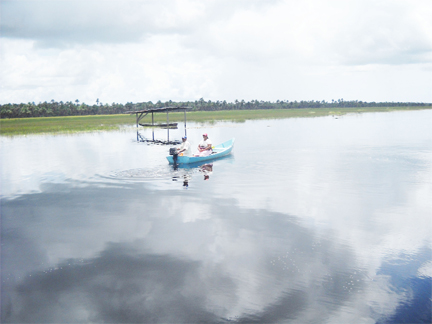For the past 30 years, Vishnu roamed the vast wetlands of the Boerasirie Conservancy, setting seines and using lines to catch “sweet-water” fish.
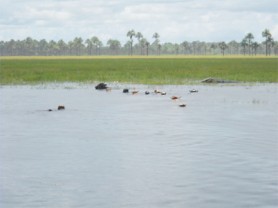
Many times he slept in a little shed built on stilts with nothing but water for miles around. Weekly, he prepared his nets, gathered his rations, hopped into his boat and headed to the desolate backlands where there was little other human contact but lots of fish. These days, like the dozens of other fisher families along the Boerasirie Conservancy Dam on the West Demerara, he worries.
“If it got to stop, it gon affect we”, he said as he lounged at a tiny wharf at the Conservancy at Canal Number Two recently. “It nah gat no other wuk foh do”.
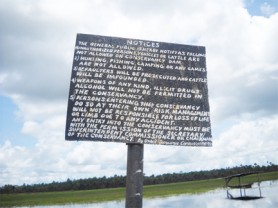
Fishing in the rivers and other waterways face increased scrutiny as the Ministry of Agriculture worries about the depletion of fish stocks. Earlier this month, the Ministry said that it will be going after those individuals who fish the inland waterways indiscriminately. The Ministry said inland fish stocks are threatened by overfishing and other activities such as logging, mining and road construction. “These activities, if not properly regulated can result in serious effects on aquatic life and the rights of Amerindian populations in the interior of Guyana,” it said.
According to the Ministry, inland fishing has increased on a commercial scale with the use of seines and nets now more prominent. Agriculture Minister, Robert Persaud has ordered the Department of Fisheries to develop an Inland Fisheries Policy to control fishing activities. Increased enforcement activities are also planned. The Ministry said that restrictions are already in place on fishing in the water conservancies and protected areas.
But Vishnu, who asked that only one name be used, said that he had been fishing unencumbered as his father did before him. “Hunting, Fishing, Camping or any Games are not allowed”, proclaims a sign at the Conservancy. On any given day, this is flouted by persons fishing for sport or to sell their catch. “Since me born and grow is fishing me ah do”, Vishnu said. “If they want stop we, they woulda stop we long (ago)”, he added hopefully. He pointed out that no one from the Ministry has formally said anything to any of them.
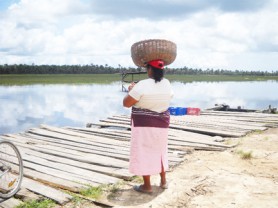
Further, the man said, the fish stocks in the conservancy are normal. But Taajnauth Jadunauth in a letter this week to this newspaper said that there is “mass destruction” of the fish population in the Boerasirie Conservancy. “Miles and miles of tangle seine and fly rods are strung along both banks of the Conservancy. These are being manned by fishermen who have camps in the Conservancy and who carry firearms”, he said. He called on “those who object to wanton and mass destruction of our sweet water fish stock… (to) bring pressure to bear on the unscrupulous fishermen to up their seines and fly rods and exit the area, and let the fish stock be replenished”.
Other residents of Canal Number Two do not have quite the same view. They point out that there are a few dozen families that depend on freshwater fishing to earn their daily bread and there are others too, who, when crops are bad and fields are flooded, they would catch fish to add to their diet. “Me ah do that one, one time”, said one man. Ganesh said that fishing the conservancy provides for his family of eight. “Dah the onliest thing they does survive pon”, he said referring to a few other families. Other residents say that there is no proper drainage in the area and when their fields flood, it is fish they depend on. “Every rainy season is flood does come”, said one. “What they gon do to all these people?”
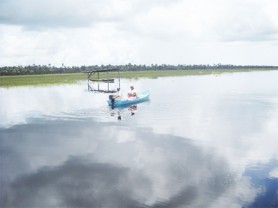
With a fish-filled basket on her head, Sita tramps down the Canal Number Two road shouting she has fish for sale. Most times the catch includes Patwa, Lukanani, Houri and Sunfish. Her husband and son are the fishermen, she the vendor. High waters in the Conservancy means a poor catch since the fish retreat to the upper reaches of the conservancy to spawn, she said. The water is high now and her fishers sometimes stay for days in the Conservancy just to get a catch that will cover their expenses. “You does got to get a good amount cause the gasoline is plenty to go where you does catch it”, she explains.
She said that they use seine “100 or so” to catch the fish. She said that they do not use so much in dry weather when it is easier. When fish are harder to catch, like now, she explains, the catch is kept alive in mesh cages in the water. Sita said that she usually has a half basket of fish for sale. “You see the foreigners that does come? This nah do foh them” she exclaims. While the fishing is their main source of income, sometimes this fails and then they buy fruits and sell. Sita also has a farm.
While many still cling to the long-standing practice, some, whose fathers were once sweet-water fishers, have moved on to other pursuits. One family in Canal Number One said that since their grandfather died, there is no one in the family who fish for a living.
Vishnu is advancing in age. For decades, he stepped into his little boat, pushed it into deeper water and roared off into the idyllic backwaters to make his living. He continues to do so. For now.

